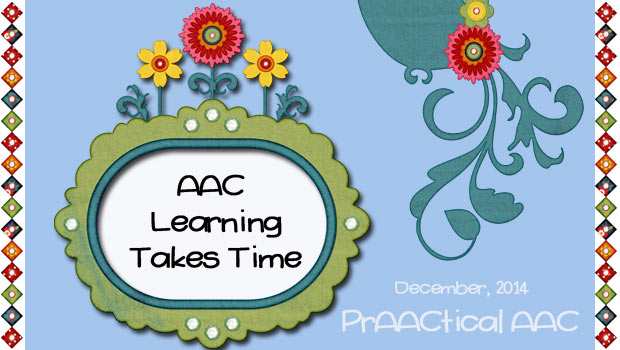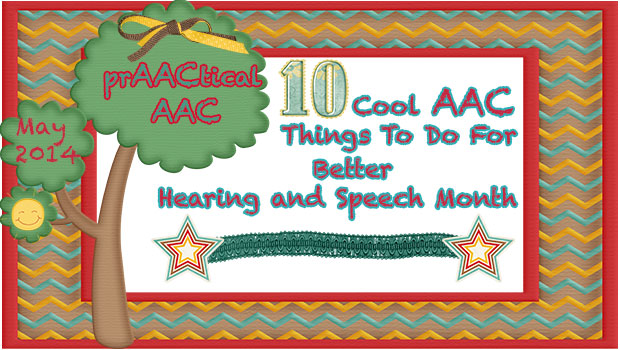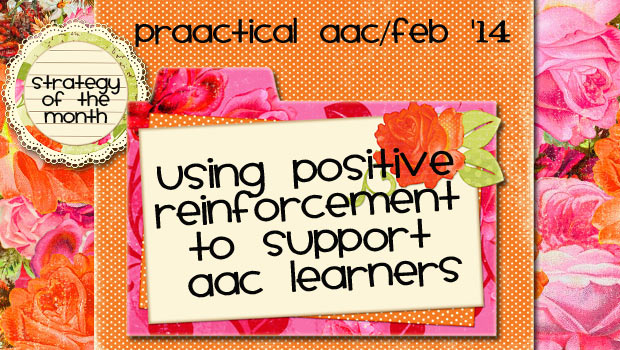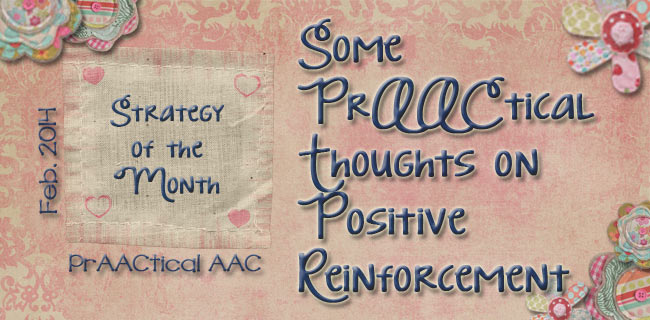The Power of Positive Reinforcement
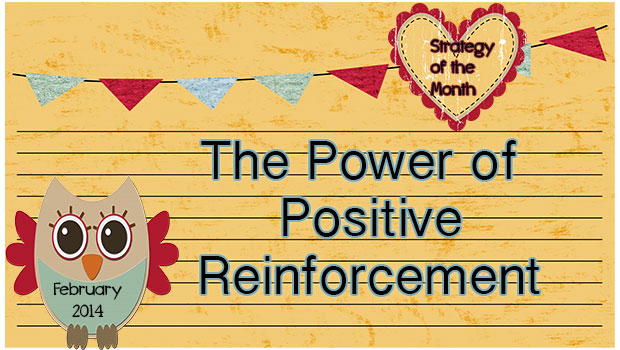
 Positive Reinforcement has a lot of power but it is a lot more than making a learner feel good about themselves. Positive reinforcement is the response to a behavior that will make that behavior occur again. In AAC and teaching terms, we are often thinking about a communicative or language behavior. We can also be thinking about a participation behavior that will allow a learner to have more access to meaningful language experiences. We are not usually thinking about ‘good art’ or ‘great work’. By keeping in mind some top positive reinforcement strategies, you will be prepared to have varied individualized strategies that will make it most likely that the communication behaviors you are teaching will spontaneously occur again and again.
Positive Reinforcement has a lot of power but it is a lot more than making a learner feel good about themselves. Positive reinforcement is the response to a behavior that will make that behavior occur again. In AAC and teaching terms, we are often thinking about a communicative or language behavior. We can also be thinking about a participation behavior that will allow a learner to have more access to meaningful language experiences. We are not usually thinking about ‘good art’ or ‘great work’. By keeping in mind some top positive reinforcement strategies, you will be prepared to have varied individualized strategies that will make it most likely that the communication behaviors you are teaching will spontaneously occur again and again.
 Power Positive Reinforcement Strategies for AAC Learners:
Power Positive Reinforcement Strategies for AAC Learners:
- Natural Positive Reinforcers– It is naturally reinforcing to ask for an item and then be given that item. It is naturally reinforcing to have something stop or end if that is your preference. It is also positively reinforcing to be given a break if that is what you want and need. The reinforcement is in the preference, not in an unrelated prize or ‘good talking’. Natural reinforcers work extremely well in AAC intervention because they show the real power of communication.
- Expansions and Extensions– Expansions and extensions are a positive reinforcement and language teaching tool that occurs in response to the communication/language that the learner uses. It can also be called ‘add a word’ strategy. If the learner uses 1 word, the adult models 2 words, if the learner uses 2 words, the adult models 3 words, etc. Expansions and extensions should be done with the AAC system as well as verbally. The AAC user benefits from seeing and hearing a next longer and complex model of the utterance.
- Social Reinforcers- There are many social reinforcers that help build confidence and the willingness to keep trying. We know AAC communication learning is not so easy. We know AAC learners often struggle with communication, language, and even behavior. The more opportunities to reinforce effort (e.g., great making that long sentence) and strategies for success (e.g., “wow, you looked at the whole page for the word”) the better for the AAC learner. Take a look at 101 positive reinforcement social reinforcers from Carole’s post: Some PrAACtical Thoughts on Positive Reinforcement.
- Specific Reinforcement- We learn from specific reinforcement rather than a general ‘good job’ or good talking’. General reinforcement does not help you know what to do next time. Instead reinforce the specific behavior you want to occur again- “Wow great reading”, “Awesome listening to both parts of the direction”, “Great letting me know the important detail”, etc.
- Authenticity- Be impressed, be REALLY impressed. Learning to communicate is hard work. Use a vocal tone that indicates you really are impressed with the ‘long sentence’ or ‘great looking hard for the word’. Be excited for the learner. By being authentic, the learner can gain confidence to keep trying as well as trust that what you say has real meaning.
- Make sure it is a Reinforcer– Reinforcers continue to evolve and change. Just because you got all the Disney stickers, does not mean they will always be a reinforcer for a specific AAC learner. Sometimes reinforcers wil last a long time, other times, they will need to be changed minute by minute. Keep on top of preferences as they relate to positive reinforcement so the strategy stays effective.
- Be a Communication Partner– Sometimes the best positive reinforcement is to be in a ‘real’ conversation where a question is answered or asked based on the true conversation. Respond contingently to what the AAC learner does or says rather than correcting or improving form or even content of the message.
- Token Reinforcers- Token boards and token reinforcers can be very helpful in helping AAC learners to learn to participate or complete specific tasks. Learning to participate more fully in a variety of activities allows for access to more communication and language opportunities. For more information on token reinforcers, check out: More Thoughts About Positive Reinforcement
- Related Tangible Reinforcers-Sometimes it may seem necessary to use tangible reinforcers in teaching. However, in the communication process, it is not meaningful to get a ‘toy’ or ‘food’ for talking or identifying words. Therefore when working on communication and language, we often like to instead stagger activities where a more difficult language activity is followed by a snack activity if food is a highly desired item. We could also stagger the complex language activity with dinosaur play if that is a preference. To go one step further, in an AAC session, we often try to embed the complex language activity in the highly desired activity rather than need to give tangible reinforcement for talking or communicating.
- Have Fun- Enjoy AAC teaching and the hard work AAC learners put in everyday to be effective communicators. Have fun being a communication partner and part of the learning process. By having fun with communication, there will be plenty of ways to be a frequent and strategic positive reinforcer.
Filed under: Strategy of the Month
Tagged With: Learning, positive reinforcement
This post was written by Robin Parker

